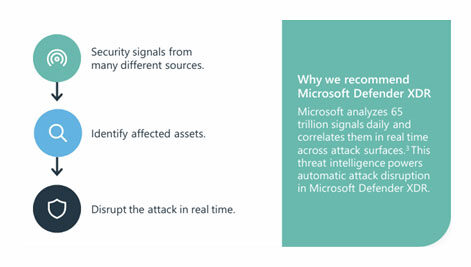The Truth About XDR: Bridging Security Gaps Across Platforms
Extended Detection and Response (XDR) started as a concept, then found itself stuck between over-promising buzzwords and a mix of new tools that do different things.1
Now, we know for certain that XDR is not a myth or another buzzword. XDR is the most effective way to enable security teams to investigate across platforms, prioritize alerts, and still have time for proactive strategies.
Keep reading to discover why XDR is essential for your cybersecurity needs.
So, What Exactly is XDR?
Attackers are getting more and more sophisticated. Once they’re in, they’re moving quickly across domains—compromising everything from endpoints to identities to data. And if you’re relying on multiple security tools, it takes time and effort to piece together alerts and event signals from all those different systems to get the full picture. If you’ve got a small team (or no security team at all), keeping up with the volume of attacks becomes nearly impossible.
Extended Detection and Response (XDR) addresses these issues by providing a holistic view of security by correlating data from across your digital estate. XDR combines threat detection, investigation, and response across security domains, including endpoints, networks, and cloud environments.
Criteria for XDR:
Here’s what an XDR program needs to have in place:
- Centralized Data Access
- Integration of Diverse Data Types and Alert Sources
- Automatic Data and Alert Correlation
- Automatic Investigation and Response
- AI and ML
And last but certainly not least, you need the people and processes to oversee and improve all of this twenty-four hour a day, seven days a week.
How is XDR different from EDR?
To put it plainly, Endpoint Detection and Response (EDR) is not enough. EDR can only help fend off endpoint-specific attacks and lacks the big picture to help with advanced attacks leaving everything else in your digital estate still at risk. While Identity Detection and Response (IDR) covers identity security. These approaches leave serious gaps in your coverage.
XDR is holistic security. It correlates signals across identities, email, endpoints, cloud apps, and more into one view. Take action to disrupt the threat based on intelligence and playbooks while alerting your SOC to they can further investigate.
XDR stands out against EDR because it has:
- Full Visibility Across the Attack Surface: XDR covers the digital estate, identifies and contains threats before they can spread.
- Alert Correlation: XDR consolidates alerts into one view, so you’re not sorting through endless notifications and scattered data.
- Automated Attack Response: AI detection capabilities identify unusual activity and disrupts attacks in-progress, so your team has time to investigate and make a plan for remediation.
- Time to Focus on the Big Picture: With XDR handling alert correlation, your SOC team can zero in on genuine threats and spend more time on proactive strategies.
To get started with XDR you don’t need to go ‘all in’ right away. Start with what matters most to your business—usually email and endpoints—and build from there. Maturity takes time, but starting small makes it a much smoother journey.
Microsoft Defender XDR: Our Choice for XDR
For organizations already invested in the Microsoft ecosystem, Microsoft Defender XDR just makes sense. It checks the box on all the required XDR criteria. It provides comprehensive protection across the digital estate, has APIs and connectors to integrate data from third-party tools, and takes proactive action against threats.
“Microsoft Defender XDR is second to none with the capabilities it offers,” says Michael Wurz, VP of Cybersecurity Solutions at ProArch. He highlights that many vendors don’t provide full support from identity endpoints to data and cloud workloads, but Microsoft Defender XDR does.
In ProArch’s own Managed Detection and Response program, we utilize Microsoft Defender XDR. As Mike Wurz shared, “Microsoft Defender XDR took action, stopped the account from having additional impact,” when one of our clients experienced a business email compromise. Defender XDR immediately disabled the compromised account, preventing the attack from spreading further and buying the security team valuable time to investigate and contain the threat before it escalated.
Security leaders are choosing Microsoft Defender XDR because it has:
- Centralized Incident Detection and Response: Defender XDR consolidates data across Microsoft 365 and cloud applications, giving your team a real-time, cohesive view of each incident.
- Automated Attack Disruption: Leveraging Microsoft’s extensive threat intelligence, Defender XDR automatically identifies, and isolates compromised accounts and devices, stopping attacks before they spread.
- Comprehensive Domain Coverage: From endpoints to emails, identities, and applications, Defender XDR provides unified coverage, making it easier for security teams to manage threats across the board.
Microsoft Defender XDR not only strengthens your security posture but also keeps things streamlined, letting your team manage complex threats in one unified system.

Read our eBook to know in detail about why we recommend XDR
Elevate Your Strategy with XDR and ProArch
By 2025, 60% of organizations are expected to use remote threat disruption and containment capabilities to stay resilient. At ProArch, we’re here to help you stay ahead of attackers with our Managed Detection and Response (MDR) services that includes XDR, or MDR Premier.
Our MDR services give you everything you need to stop threats in real time and prevent security incidents that could disrupt business operations.
Contact ProArch today to learn more about our Managed Detection and Response services.

Assistant Manager Content Parijat helps shape ProArch’s brand voice, turning complex tech concepts into clear, engaging content. Whether it’s blogs, email campaigns, or social media, she focuses on making ProArch’s messaging accessible and impactful. With experience in Oracle, Cloud, and Salesforce, she blends creativity with technical know-how to connect with the right audience. Beyond writing, she ensures consistency in how ProArch tells its story—helping the brand stay strong, authentic, and aligned with its vision.
